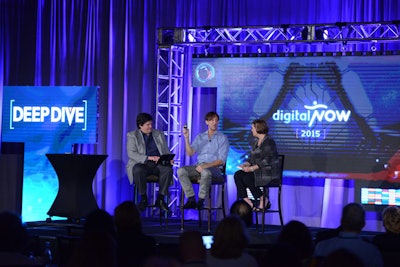
David Bell, a marketing professor at the Wharton School at the University of Pennsylvania, researches how people use the Internet and related technologies to search, shop, and sell. Following his recent keynote at DigitalNow, produced by Fusion Productions and held at the Walt Disney World Swan and Dolphin Resort, he spoke to BizBash about how the principles of online consumerism apply to marketing for conferences, trade shows, and other events.
What can planners learn about face-to-face experiences from trends in e-commerce?
People are still inherently social. The digital channels are not necessarily a substitute for the offline channel, but it can be a complement. You see this in certain commercial fields. All these companies that got their start online now have pop-ups or stores—even Google and Amazon are going down that route. For certain people or certain situations, a physical experience is still important. And if you create these physical experiences, what you can do now because of digital is share them and amplify them. The campaign Doritos did around being bold, a lot of it was digital but then they were picking up these people, driving them around and taking them partying around this theme of being bold and then creating interesting content that could be shared.
Nearly everyone nowadays has at least one mobile device with them at all times, and you’ve said that drives certain behaviors that brands should capitalize on, such as the concept of “snacking.” What does that mean?
People’s attention spans are shorter. It used to be the case that you and I would walk down the street in New York City just kind of zoning out, which can be good for your brain, clearing your thoughts. But now you see in any city, elevator, subway, coffee cube, people are constantly involved with their device, either creating or consuming content. So companies need to recognize that that’s such a pervasive phenomenon, and figure out how to fit in with that behavior. Certain brands are very good at this. Sephora has great content that people can engage with quickly. One way is going to short stuff like Vine and Snapchat. Short-form, snackable content is going to be really important for all kinds of domains.
As companies try to figure out how to use technology to improve the customer experience, you’ve suggested they should start by answering the question, “What’s wrong with the status quo?” When it comes to conferences and events, how do you suggest planners do this?
There are sort of two routes. One is you can ask people, but sometimes it’s hard to elicit opinions. If you do surveys it might only be the people who are really happy or really angry that respond. So the other one is to act like a bit of an anthropologist and just go through it yourself. You do something like your own mystery shopping. Pretend that you are a participant. Go through the whole process, from registering to attending the events, from eating the food, from staying at the hotel. Ask yourself, "Were there any pain points, any friction?" You see a lot of good companies do this. Richard Branson will take a flight on one of his planes just to see how it’s going. Or you can ask who’s best in class that is doing things that are adjacent to what we are doing. Or even someone in a totally different business that is phenomenal at developing a customer experience. What do they do? What can we learn from a brand like Warby Parker or Apple or whoever we really aspire to?
Why are online reviews so powerful?
Information drives choice. Seventy-five percent of all decisions that we make are preceded by a review. … The reason we all rely on them is because for a lot of things we’re about to do, it’s our first time doing them—the first time staying in a hotel in Orlando, the first time buying a pair of pants online, the first time attending a conference. So because it’s the first time you’d like to get some information that reduces your friction or uncertainty. There’s an endless list of these things that potentially are reviewable. In the digital world, helping customers make decisions and eliminating friction is an incredibly important thing to do.
So if most of the decisions we are making are driven by information from other people, how can brands and planners use that concept to generate new customers?
It’s about referrals. So if I referred something to you, the number one virtue is it’s going to be relevant to you, so you are probably better than some random customer. I’ve already selected you—the selection effect. And number two, because that’s how you learned about it, you are more likely to do the same thing and refer it to someone else. That’s the treatment effect. So those are two really important benefits. But how do you get that process going? There has to be some sort of carrot that you dangle out—an extrinsic reward or intrinsic reward. But if you can get that reward package right, for sure you should see both of those benefits.



















